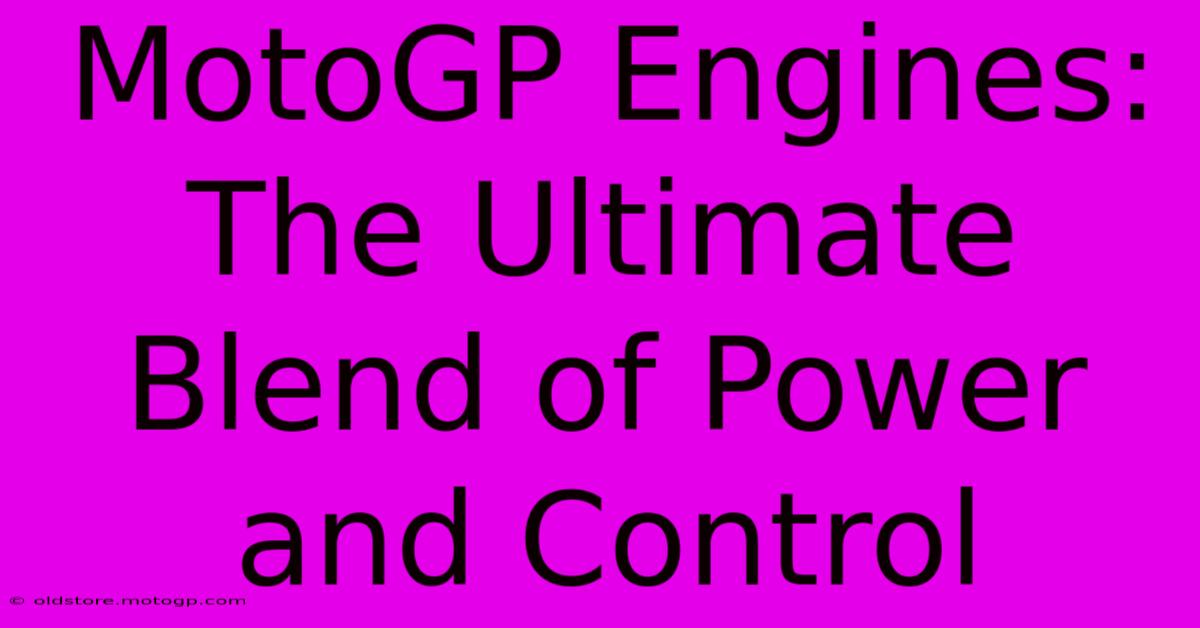MotoGP Engines: The Ultimate Blend Of Power And Control

Table of Contents
MotoGP Engines: The Ultimate Blend of Power and Control
MotoGP, the pinnacle of motorcycle road racing, showcases a breathtaking spectacle of speed, skill, and technological prowess. At the heart of this spectacle lies the MotoGP engine – a masterpiece of engineering that delivers incredible power while demanding precise control. This article delves into the intricacies of these high-performance powerhouses, exploring their design, technology, and the relentless pursuit of optimization that defines the championship.
The Powerhouse Within: Engine Specifications
MotoGP engines are four-stroke, 1000cc prototypes, representing the cutting edge of motorcycle engine technology. While the regulations evolve, key characteristics remain consistent:
- Four-Stroke Design: This design offers a balance of power and reliability crucial for the demanding nature of MotoGP races. The controlled combustion process enhances efficiency compared to two-stroke counterparts.
- 1000cc Displacement: This displacement limit encourages innovation within a defined parameter, pushing engineers to extract maximum power and performance from a relatively constrained engine size.
- Inline Configuration: Most MotoGP engines feature an inline configuration, offering optimal weight distribution and a compact design. The inline layout also simplifies the crankshaft design, contributing to reliability.
- High RPM Operation: These engines rev exceptionally high, typically exceeding 16,000 RPM, significantly higher than engines found in standard production motorcycles. This high RPM operation is key to unlocking significant power.
- Sophisticated Electronics: Engine management systems play a crucial role, precisely controlling fuel injection, ignition timing, and other parameters for optimal power delivery and seamless throttle response. Sophisticated sensor data contributes to this precise control.
Materials Science and Manufacturing: Pushing Boundaries
The construction of MotoGP engines is a testament to materials science advancements. Lightweight yet incredibly strong materials like titanium, magnesium, and carbon fiber are heavily utilized to minimize weight while maximizing durability. Precision manufacturing techniques ensure tight tolerances and optimal engine performance. The meticulous craftsmanship contributes directly to the engine's ability to withstand the immense stresses of racing.
Achieving the Perfect Balance: Power and Control
The goal isn't simply to create the most powerful engine; it's about achieving a harmonious balance between raw power and precise control. This balance is paramount for riders to exploit the engine’s capabilities effectively while maintaining stability and control, especially during cornering at incredibly high speeds. The fine-tuning process is a continuous quest for optimization.
Advanced Technologies for Optimal Performance
Several advanced technologies contribute to this delicate balance:
- Pneumatic Valves: Some teams utilize pneumatic valve actuation systems for incredibly precise and rapid valve control, maximizing engine breathing efficiency at high RPM.
- Seamless Shift Technology: Quick-shifters allow for clutchless upshifts and downshifts, maintaining momentum and reducing rider fatigue during intense races.
- Traction Control: Sophisticated traction control systems constantly monitor wheel spin and adjust engine power delivery, preventing loss of control and maximizing acceleration out of corners.
- Anti-Wheelie Control: This feature manages engine output to prevent the front wheel from lifting off the ground, ensuring stability under hard acceleration.
- Engine Brake Control: Engine braking control allows for precise deceleration, aiding riders in smoothly navigating corners and maintaining control.
The Ongoing Evolution: Continuous Improvement
MotoGP engine technology is in a constant state of evolution. Teams and manufacturers continuously strive to find marginal gains in power, efficiency, and control, employing cutting-edge simulation, advanced materials, and innovative design strategies. Each race is a testing ground, providing valuable data that informs further development.
Conclusion:
MotoGP engines represent the pinnacle of motorcycle engine technology, a testament to human ingenuity and the relentless pursuit of performance. The intricate balance between raw power and precise control, achieved through advanced engineering and cutting-edge technology, makes them truly remarkable machines. The ongoing evolution ensures that the future of MotoGP engines promises even greater levels of performance and excitement.

Thank you for visiting our website wich cover about MotoGP Engines: The Ultimate Blend Of Power And Control. We hope the information provided has been useful to you. Feel free to contact us if you have any questions or need further assistance. See you next time and dont miss to bookmark.
Featured Posts
-
Experience The Adrenaline Rush Of Circuit Racing
Feb 21, 2025
-
The Hottest Tickets In Town Cota Concert Schedule
Feb 21, 2025
-
Motorcycle Racing And Career Development Transferable Skills And Opportunities
Feb 21, 2025
-
The Moto Gp Goat A Legacy Of Passion
Feb 21, 2025
-
The Hottest Ticket In Town F1 Austin 2025
Feb 21, 2025
